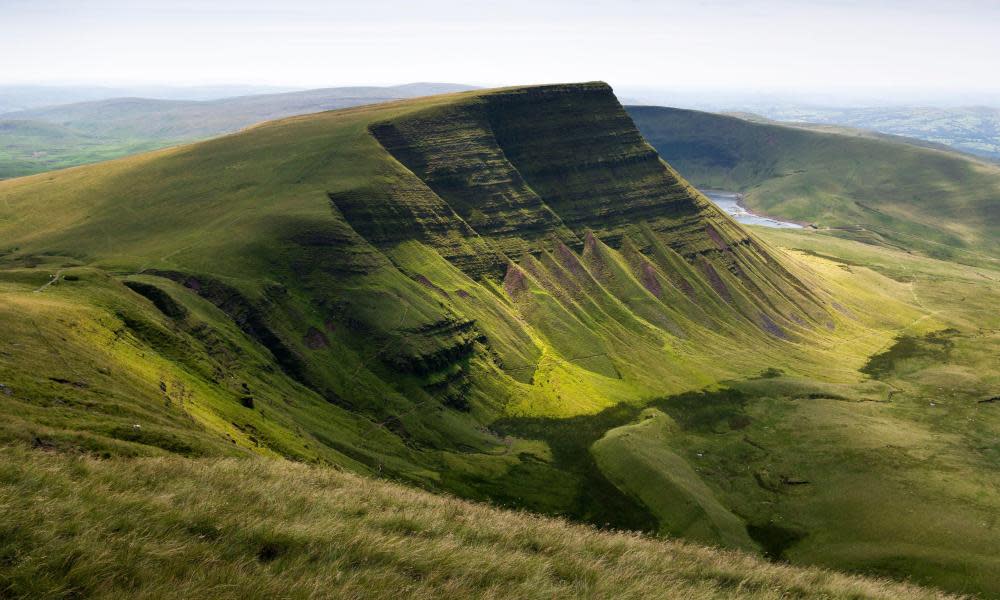Brecon Beacons national park renamed Bannau Brycheiniog in Welsh language move

The name and logo is familiar to the hundreds of thousands of people who visit every year to climb the peaks, explore the fast-flowing streams and rivers and unwind in the towns and villages.
But from Monday the Brecon Beacons national park is dropping its English language name and scrapping its logo of a fiery greenhouse gas-emitting beacon as it launches a plan designed to tackle issues in the park created by the climate and biodiversity emergencies.
The park in southern Wales is to be known as Bannau Brycheiniog – pronounced Ban-eye Bruck-ein-iog – national park or informally The Bannau.
Bannau is the plural of “ban”, which means peak in Welsh, while Brycheiniog refers to the kingdom of the fifth-century king Brychan, so the name translates into English as the Peaks of Brychan’s Kingdom.
The new logo is more muted and features nods to a king’s crown and the starry skies, hills and watercourses of the park.
The launch is being promoted with a stirring short film, written by the novelist, poet and playwright Owen Sheers, who was brought up in an old Welsh longhouse outside Abergavenny, and featuring the actor and activist Michael Sheen, who hails from south Wales.
It is entitled Cynefin, a Welsh word that Sheers defines as “a landscape which, as you step into it, feels like arriving at your hearth” and opens with Sheen striding across a beautiful hillside.
The film, however, cuts to less picturesque aspects of the park including dumped rubbish, polluted water and wildfires. It depicts a depleted landscape where birds such as the curlew, swallow and rook are struggling and rivers – the “veins” of the landscape – are sluggish with nitrates and phosphates.
According to the film, this is a place “hooked” on carbon, diesel, petrol and oil, and with a human population that is growing older, younger people forced out because of the lack of well-paid jobs and affordable housing.
The film looks forward to a better future that it hopes the new plan will create – skies filled with birds, dark nights “thick with stars”, water running “with life, not pollution” and young people nurtured by culture and educational opportunities.
Explaining why he was keen to be involved in the launch, Sheen said the park was much more than a place of beauty and inspiration.
“National parks have a vital role to play in providing for nature, for people, and for our shared future,” he said. He welcomed the reclamation of the Welsh name as “an old name for a new way of being”.
The rationale for the name and logo change is that the 520 sq miles (1,350 sq km) of park covers a much greater area than the central Beacons range – and that it shows a commitment to the Welsh language.
As well as the flaming beacon not fitting with the park’s ethos, the management says there is no evidence of burning beacons ever existing on its summits.
The park authority CEO, Catherine Mealing-Jones, said: “The more we looked into it the more we realised the name Brecon Beacons doesn’t make any sense. It’s a very English description of something that probably never happened. A massive carbon-burning brazier is not a good look for an environmental organisation.”
Snowdonia national park authority voted last year to use Yr Wyddfa and Eryri rather than Snowdon and Snowdonia after 5,000 people signed a petition calling for the change.
“Welsh names are beautiful,” Mealing-Jones said. “They are very descriptive. We’re not demanding people use the Welsh name, but gradually it will catch on, hopefully.”
The management plan sets goals including reaching net zero greenhouse gas emissions across the park by 2035, ensuring water resources and water environments are clean, safe and resilient by 2030 and creating thriving and sustainable places for people as well as nature.
It flags up problems such as the second-home crisis that is hollowing out communities and the issue of some of the park’s favourite spots such as Sugar Loaf mountain suffering because they draw too many visitors. But it is also keen to make the point that everyone must feel welcomed in the park regardless of their background.
The plan includes images of what it hopes the park can become within 25 years – still beautiful, with more biodiversity, a recovering natural world and lively communities.
Mealing-Jones said: “People are making a living in the park. There are still sheep on the hills, still cattle grazing. But there are more trees, peatland is being restored, species are coming back. There are small-scale market gardens, small wind turbines, vineyards, water being slowed down. It is a reinvention of what a national park is all about, a picture of hope for the future.”

 Yahoo News
Yahoo News 
